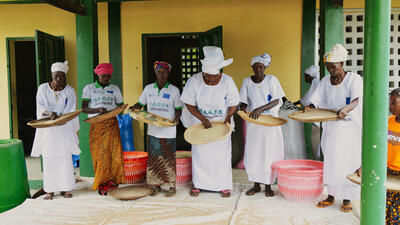
Made-in-Guinea: Improving market access for shea butter
Women in Guinea are teaching their communities how to meet international standards for shea butter, so they can earn more from global cosmetics
The multi-billion-dollar cosmetics and skincare industries prize shea butter as a natural moisturizer. But the women who harvest shea nuts across West Africa can’t afford to buy the products that result from their labour.
To change that dynamic, 20 women from Guinean cooperatives spent a month in the town of Kankan learning management and production techniques that they’ll take home to teach their cooperatives.
In Guinea, women do the work of collecting shea nuts, roasting the kernels, and physically extracting the butter. The UN Development Programme estimates that shea value chains provide jobs for three million women each year.
Equipped with better knowledge on what international markets are looking for, the cooperatives hope to fetch better prices for their harvests, boosting women’s incomes in the process.
“As part of the demonstration, we followed all the necessary procedures for producing shea butter,” said Keita Aminata, president of Kakidi, a union within COPRAKAM. “We double-washed the kernels, for instance, to eliminate any possibility of contamination. In the past, we sometimes did not thoroughly wash the kernels before use. Similarly, we did not always carefully sort them to remove the rotten ones.”
The SheTrades West Africa project at the International Trade Centre ran the training as part of its support for Made-in-Guinea shea butter production and supporting the women behind it.
The participants came from three shea cooperatives: COPRAKAM, FUPROBEK, and BABIA. The 20 women then shared their knowledge with 311 more women in their communities.
Becoming market-ready
To produce high-quality shea butter that meets international standards, the women learned proper conditioning and storage methods.
They also learned health and safety procedures to use in managing their cooperatives, and how to increase their production by using fuelwood and water efficiently.
As agripreneurs, the women were introduced to regional and international shea industry dynamics. They learned the ins and outs of markets and trading – from quality standards sought by buyers, to creating new market linkages, building lasting relationships, and negotiating contracts.
By preparing women to teach others within their communities, the new skills and knowledge can reach producers even in hard-to-reach rural communities.
”With our new understanding of the role that high-quality products play in securing solid sales, we commit to sharing this information with every member of our cooperatives,” Aminata said.
“I am glad that I can share this knowledge with even the most rural of communities, and I encourage everyone I teach to pass it forward.”















